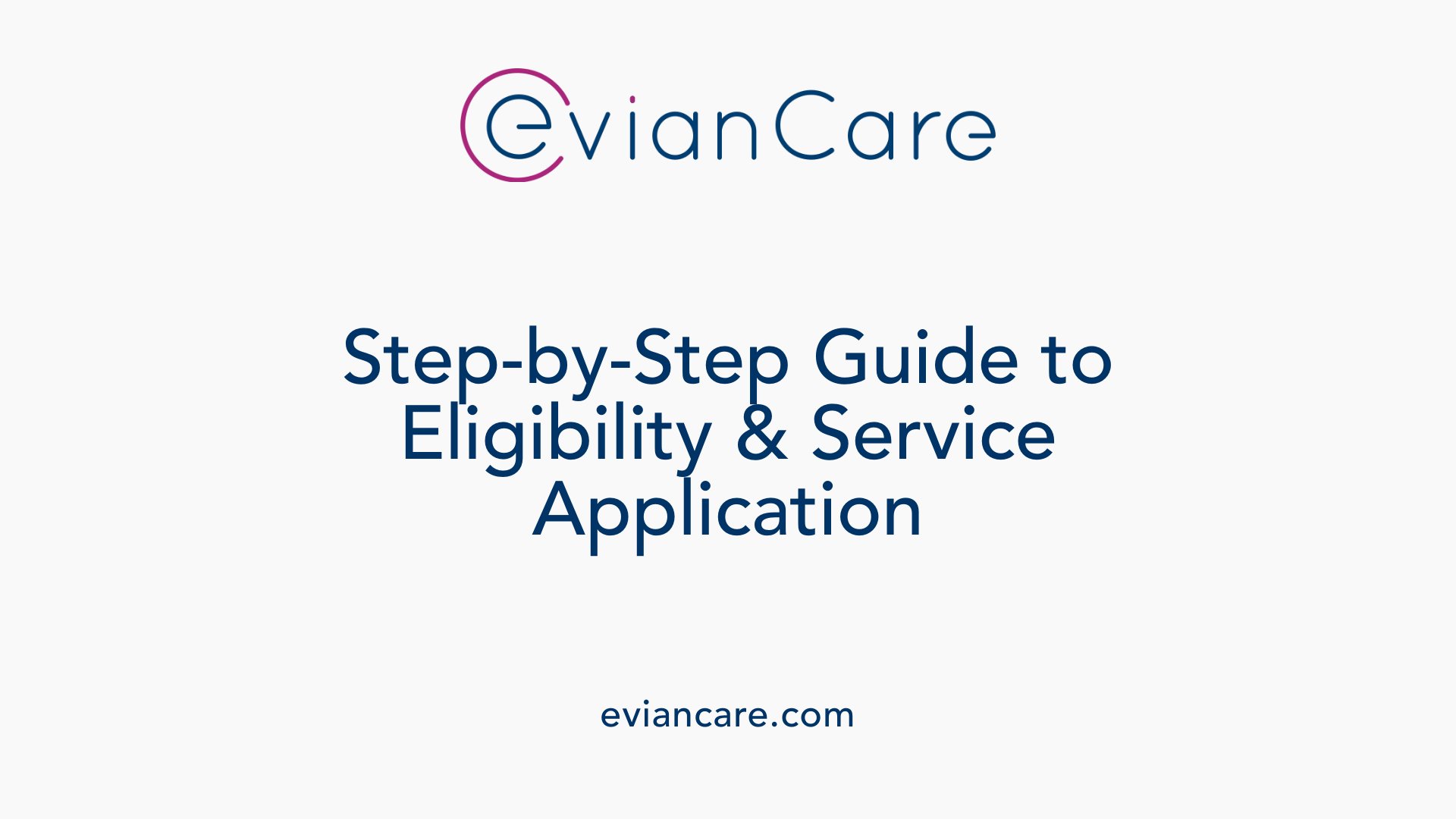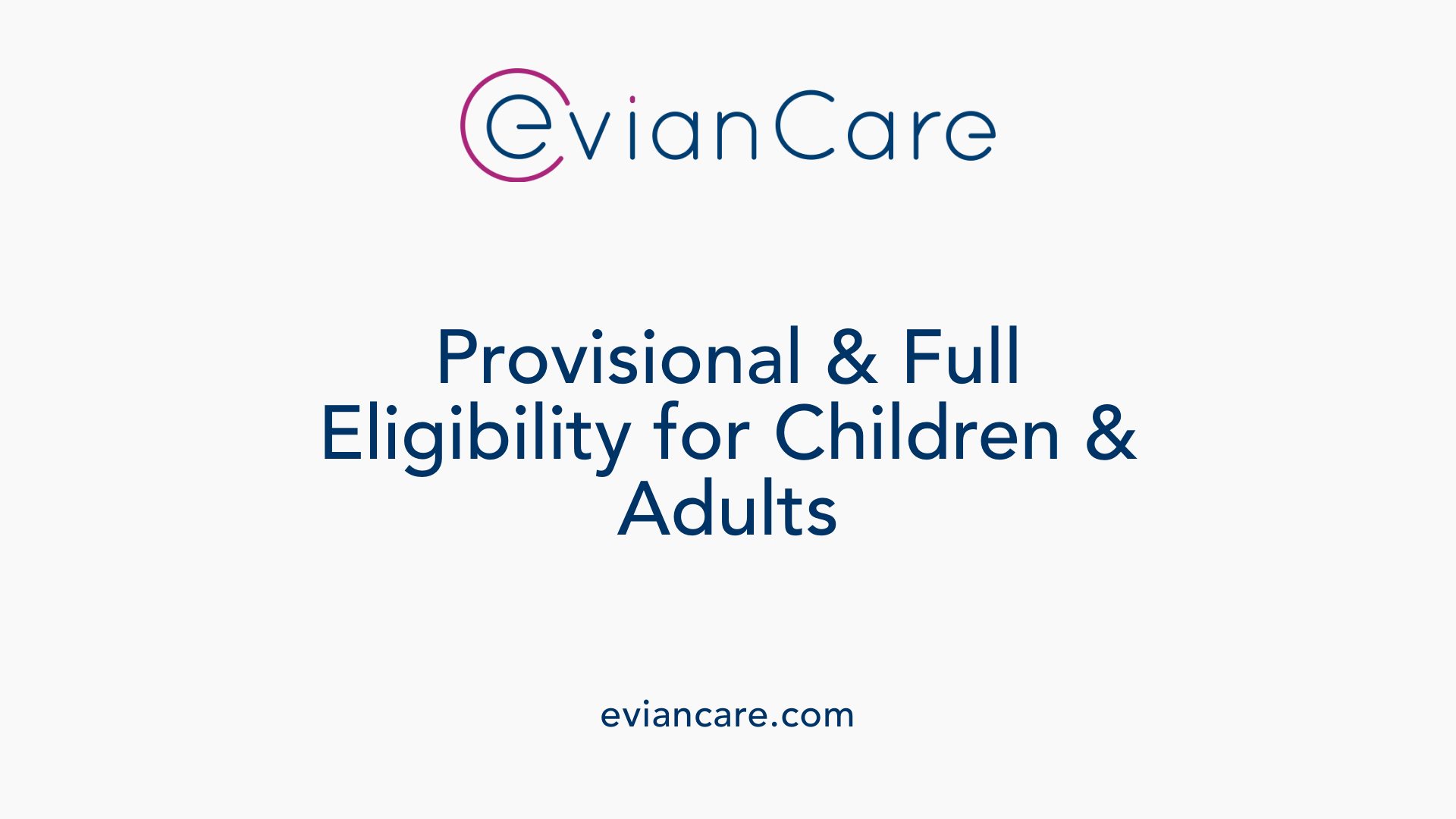
Understanding the Foundations of Eligibility for DDD Services
California's developmental disability (DD) services are comprehensive and designed to support individuals from infancy through adulthood. These services, administered through regional centers, are guided by strict eligibility criteria rooted in state and federal law. This article provides an in-depth look at the requirements, diagnosis procedures, and application processes necessary to qualify for services such as the California Department of Developmental Services (DDS) programs and regional center supports, emphasizing the legal framework and specific conditions involved.
Legal and Official Eligibility Criteria Defined by the Lanterman Act

What are the official eligibility criteria outlined by the Lanterman Act?
The Lanterman Act provides the legal framework for determining eligibility for services through regional centers in California. To qualify, an individual must have a diagnosed developmental disability such as intellectual disability, autism, epilepsy, or cerebral palsy. The disability must originate before age 18 and be expected to continue indefinitely. Importantly, it must result in a substantial impairment in at least three of several key areas: self-care, language, learning, mobility, self-direction, or independent living. For children aged 3 or 4, the law allows provisional eligibility even without a formal diagnosis. In such cases, demonstrating significant functional limitations in at least two major life activities suffices, with the eligibility lasting until age 5. The emphasis is on the ongoing impact of the disability on daily functioning, making assessments and evaluations central to the process. All eligibility decisions are reviewed periodically, and an Individual Program Plan (IPP) is developed to tailor services to each individual's needs.
What are the eligibility criteria for developmental disability services in California?
Eligibility criteria for services are defined by state legislation and involve diagnosis and assessment by regional centers. The core requirements include having a developmental disability that began before age 18, is expected to last for a lifetime, and substantially limits at least three major areas of life. For infants and toddlers (birth to 36 months), criteria include exhibiting significant delays—at least 25% in areas like cognition, communication, social/emotional skills, adaptive behavior, or physical and motor development. High-risk conditions such as genetic syndromes or prenatal exposures can also establish eligibility. Children aged 3 to 4 can qualify provisionally based on documented functional limitations without a formal diagnosis. For older children and adults, conditions such as autism, cerebral palsy, epilepsy, and intellectual disabilities are typical qualifying diagnoses, provided they meet the age-related criteria and impact. Assessment tools—like developmental screenings, behavioral evaluations, and genetic testing—are utilized to determine eligibility.
Who qualifies for regional center services in California?
In California, individuals qualify for regional center services if they have a developmental disability diagnosed before age 18, which is expected to be lifelong and substantially disables them. Eligibility extends to those with conditions including autism, cerebral palsy, intellectual disability, and epilepsy. The process involves a comprehensive diagnosis and assessment conducted by regional centers. This process is free of charge to the family or individual. Eligibility criteria vary by age group:
- Infants and toddlers (0-36 months): evaluated based on delays or high-risk factors.
- Children aged 3 to 4: may qualify provisionally based on functional limitations regardless of formal diagnosis.
- Children 3 and older: diagnosed conditions and substantial functional limitations in multiple domains are required. Residency in specific counties, such as Del Norte, Humboldt, Lake, Mendocino, Riverside, San Bernardino, or the broader designated regions, determines regional center service eligibility.
What conditions qualify a child for the Early Start program in California?
The Early Start program targets infants and toddlers from birth to 36 months who demonstrate developmental concerns. Eligibility requires:
- At least a 25% delay in one or more developmental domains, including cognitive, language, social, emotional, adaptive, or physical development.
- High risk for delays due to known etiology, such as genetic syndromes, prematurity, or prenatal substance exposure.
- An established risk condition diagnosed medically with a high probability of resulting in developmental delays. Children must be residents of California, and evaluations are conducted shortly after referral, typically within 45 days. Services under Early Start are provided at no cost, facilitating early intervention to support optimal development.
How are developmental disabilities diagnosed?
Diagnosing developmental disabilities involves a multifaceted approach. Healthcare professionals, including pediatricians, psychologists, and neurologists, conduct screening tests and behavioral assessments to evaluate a child's developmental skills. Standardized tools measure cognitive, language, motor, and adaptive behaviors, helping identify delays or impairments. Prenatal genetic testing, such as amniocentesis or chorionic villus sampling, can identify genetic conditions prior to birth that might lead to disabilities. Postnatal diagnosis often involves developmental evaluations, IQ testing, and assessments of adaptive functioning. Early detection allows for timely intervention, improving long-term outcomes. Overall, combining clinical observation, standardized assessments, and medical testing provides a comprehensive picture of a child's developmental status, guiding eligibility and intervention planning.
| Aspect | Details | Relevant Laws/Notes |
|---|---|---|
| Eligibility Age Range | Birth to 36 months, 3-4 years, 3+ years | Based on age-specific guidelines |
| Conditions Qualifying | Autism, cerebral palsy, intellectual disability, epilepsy, other closely related conditions | State laws define qualifying diagnoses |
| Assessment Process | Screening, behavioral evaluations, medical testing, genetic analysis | Conducted by regional centers |
| Functional Limitations | Significant impairments in areas like self-care, communication, learning, mobility, self-direction | Must affect multiple life areas |
| Provisional Eligibility | Allowed for children aged 3-4 with functional limitations but no formal diagnosis | Valid until age 5 |
| Service Regions | Specific counties such as Del Norte, Humboldt, Lake, Mendocino, Riverside, San Bernardino | Residency required |
| Legal References | Sections 95014 and 4512 of California Welfare and Institutions Code | For detailed legal criteria |
This comprehensive overview emphasizes the structured process in California for diagnosing and establishing eligibility for various developmental disability services. It underscores the importance of early assessment and tailored planning to support individuals across their lifespan.
Assessment and Application Processes for Eligibility

What is the process for assessment and application for services?
The pathway to receiving developmental disability (DD) services in California begins with an online application process. Caregivers or individuals create an account through the official portal, such as 'Sign in · My Alta'. This portal serves as the main point to submit referrals, schedule assessments, and access services.
For infants and toddlers, assessments are typically conducted virtually by regional centers. These evaluations determine if the child exhibits a developmental delay of at least 25% in areas like cognition, communication, social-emotional skills, adaptive behaviors, or physical/motor development. Alternatively, if the child has an established risk condition with a high likelihood of delay, they may qualify for services even without a significant delay.
Children aged three and older, as well as adults, undergo evaluations by qualified professionals—such as psychologists—to establish the presence of a developmental disability. This process involves reviewing medical histories, observing behaviors, and conducting standardized tests. Once an assessment confirms eligibility, a formal determination is made.
Following eligibility confirmation, an Individual Program Plan (IPP) is developed. This plan outlines specific services tailored to the individual's needs, which are provided at no cost. The entire process prioritizes thorough assessment, transparent procedures, and prompt delivery of support.
What are the age-specific application procedures?
Application steps differ across age groups. For infants and toddlers, caregivers start by creating an account on the designated online portal. They then submit assessments for early intervention, which need to be completed promptly — often within 45 days of referral.
For children aged three and older or for adults, individuals or their guardians also set up accounts through the portal to request assessments. The application involves providing detailed developmental and medical histories, completing screening forms, and participating in professional evaluations.
Once an evaluation confirms a developmental disability or significant delay, eligibility is officially granted. The regional center communicates the decision, after which a comprehensive service plan, the IPP, is prepared to support the individual's ongoing needs.
What is the significance of diagnosis in the eligibility process?
A formal diagnosis is central to the eligibility framework for DD services in California. It offers an official recognition that an individual has a developmental disability—such as autism, cerebral palsy, intellectual disability, or epilepsy—based on standardized assessments by qualified professionals.
Diagnoses must typically be made before age 18 and should indicate the condition is expected to persist indefinitely. Establishing an accurate diagnosis enables regional centers and the Department of Developmental Services (DDS) to determine the severity of the disability, its impact, and the appropriate services.
In cases where a formal diagnosis is not immediately available, especially for very young children or those at risk, provisional eligibility may be granted based on severe functional limitations. Nonetheless, a confirmed diagnosis ensures access to the full spectrum of services, guiding effective intervention, family support, and legal rights.
These assessment and application procedures are designed to be comprehensive, accessible, and equitable, ensuring every eligible individual in California receives the supports they need to thrive.
Age Groups and Specific Eligibility Conditions

What are the eligibility conditions for children and adults?
In California, the criteria for obtaining services through regional centers are designed to identify individuals with developmental disabilities that significantly impact their daily functioning. For children, eligibility begins from birth and extends up to 36 months under the Early Start program. To qualify, infants and toddlers must either exhibit at least a 25% delay in one or more developmental areas such as cognitive, communication, social/emotional, adaptive, or physical and motor skills, or they must have an established risk condition with a high probability of delay. These conditions include severe vision or hearing impairments, orthopedic issues, or other biomedical factors.
As children grow older, specifically from age 3 onwards, the criteria expand to include specific diagnoses such as autism, cerebral palsy, epilepsy, and intellectual disabilities. For children aged 3 and 4, provisional eligibility can be granted without a formal diagnosis if the child shows significant functional limitations in at least two major life areas like self-care, language, learning, mobility, or self-direction. This provisional status ensures that children with suspect or emerging disabilities have access to necessary services while awaiting further assessment.
Adults with developmental disabilities qualify when they demonstrate significant limitations in at least three areas, including self-care, communication, learning, mobility, self-direction, independent living, or economic self-sufficiency. These criteria aim to ensure that services go to individuals with substantial and enduring needs. The eligibility process involves diagnosis and assessment performed by regional centers, which rely on state and federal laws for defining developmental disabilities.
The law stipulates that the disability must have begun before age 18, be expected to continue indefinitely, and result in a substantial disability, which generally involves major impairments in three or more areas of functioning. The purpose of these detailed conditions is to focus resources on those most in need of interdisciplinary support.
What are provisional eligibility criteria for young children?
For children aged 3 and 4, provisional eligibility offers a crucial pathway to access early intervention services even when a definitive diagnosis has not yet been made. Under California law, particularly Section 4512(a)(2) of the Welfare and Institutions Code, a child can qualify provisionally if they demonstrate significant functional limitations in at least two major life areas such as self-care, language, learning, mobility, or self-direction.
This provisional status is especially important for children who exhibit clear challenges but whose diagnostic evaluation is ongoing. It allows early service provision, which can significantly influence developmental trajectories. The eligibility can be granted without a formal diagnosis, relying instead on assessments that demonstrate the child’s need for support. The provisional status remains until the child turns five, after which a formal diagnosis or additional evaluation may be required for continued eligibility.
This flexibility ensures that children with substantial developmental needs are not delayed in receiving crucial early interventions. Early Start services, available for children from birth to 36 months, are essential for fostering development, especially for those at risk of future disabilities. Provisional eligibility thus forms a vital component in ensuring timely support and comprehensive developmental care.
Ensuring Access Through Clear Eligibility Guidelines
Understanding the eligibility requirements for DDD services in California is essential for families, caregivers, and professionals seeking support for individuals with developmental disabilities. State laws like the Lanterman Act establish comprehensive criteria based on diagnosis, functional limitations, and age-specific developmental needs. The assessment process, which involves evaluation by regional centers and licensed professionals, is designed to ensure appropriate and timely access to services. Whether for infants, children, or adults, knowledge of these legal and procedural requirements helps families navigate the application process and secure vital supports to enhance quality of life and independence.
References
- Regional Center Eligibility & Services
- Eligibility Criteria for Regional Center Services
- Am I Eligible
- Am I Eligible? - Alta California Regional ...
- » Am I Eligible For Services?
- Eligibility - North Los Angeles County Regional Center
- Eligibility
- Eligibility Criteria: Ages 3 and Older
- Eligibility
- (2.23) Am I eligible for regional center services if I have only a ...












